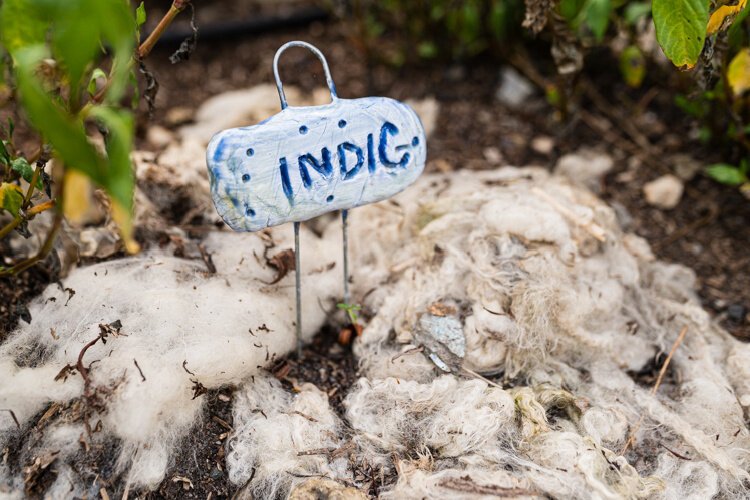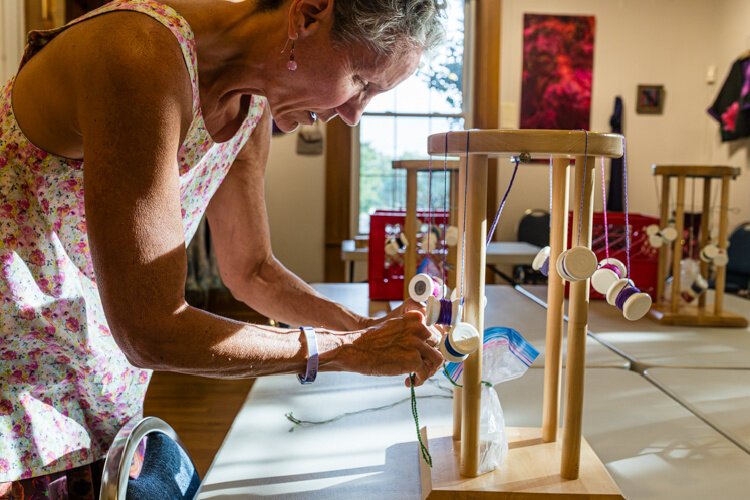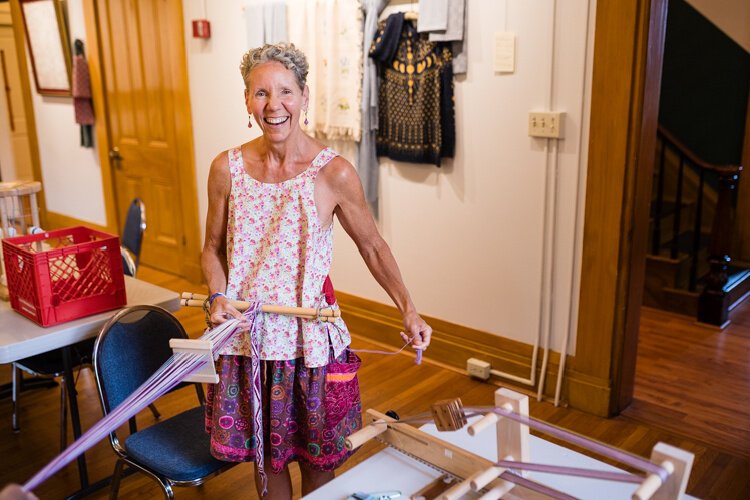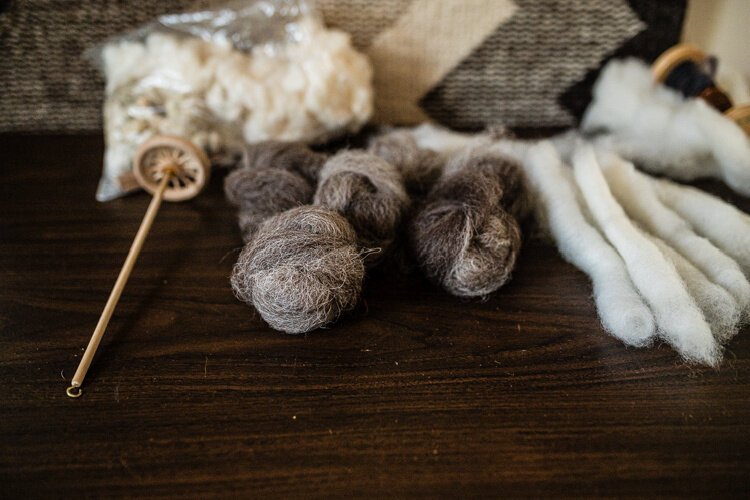(Still) Made in Cincinnati: The Weavers Guild—craft, tradition, and community
(Still) Made in Cincinnati: The Weavers Guild—craft, tradition, and community
Weaving is one of the world’s oldest crafts.
For as long as humans have walked the earth, they’ve invented ways to harvest or create fiber and thread and weave it into textiles for clothing, shelter, and adornment.
Over time, textiles have evolved through technological innovation, but the modern fiber industry is still built on the same fundamental methods of spinning, dyeing, braiding, and weaving.
The Weaver’s Guild of Greater Cincinnati was founded in 1948 and held its first meetings at the Cincinnati Art Museum. Its mission was to promote handweaving.
After adopting a few different meeting locations throughout the years, the nonprofit is now owner and steward of a building they call “The Guild House,” a looming Greek Revival home on Gray Road in Spring Grove Village.
In the Guild House, the walls are lined with colorful textile artwork. There is a room of spinning wheels and a room (or two) of weaving looms. There is a room with fiber samples and artwork for sale, a kitchen with large stainless steel sinks for dyeing, and a library lined with books and magazines about the craft.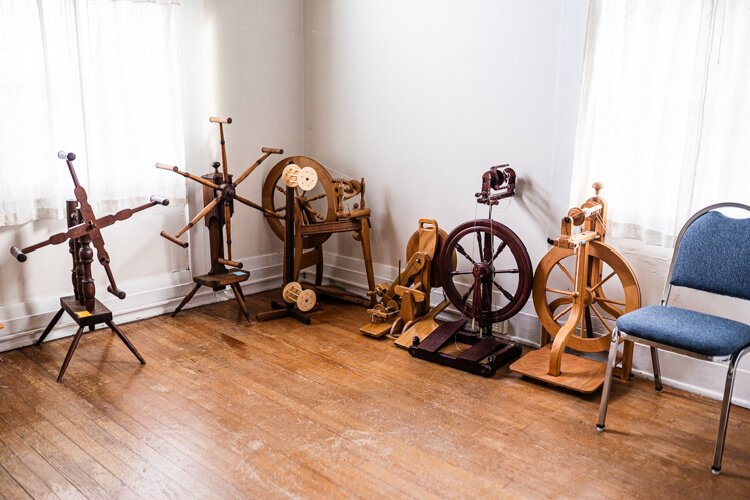 There is a room of spinning wheels at “The Guild House.”The Weavers Guild of Greater Cincinnati is a member-d nonprofit with a group of volunteers who teach classes, organize public events, and raise funds for the organization. Among its nearly 200 members are business professionals, students, grandparents, college professors, stay-at-home moms, and retirees.
There is a room of spinning wheels at “The Guild House.”The Weavers Guild of Greater Cincinnati is a member-d nonprofit with a group of volunteers who teach classes, organize public events, and raise funds for the organization. Among its nearly 200 members are business professionals, students, grandparents, college professors, stay-at-home moms, and retirees.
Some members are beginners, learning basic skills of braiding, weaving, and spinning yarn; others are experts in their craft, with decades of experience and training. Everyone is always learning something new and everyone is welcome.
Spinning, Dyeing, Weaving
Depending on the day, members of the Guild might be perched over looms, sitting at large vintage spinning wheels, or rhythmically winding yarn on handheld spindles while chatting with friends. They might be weaving baskets or dyeing their handspun yarn. Some will stop in for study group meetings or to borrow tools for their personal projects.
Some come to learn; others come to teach them.
Pat Maley is one of the Guild’s resident spinning experts and instructors. She used to teach college-level textiles classes and does demonstrations at historical events. She joined the Weavers Guild in 1969 and has been spinning and weaving for over 50 years.
She says people are still interested in learning how to spin because nothing quite compares to homespun yarns.
Between choosing fibers, choosing the weight (thickness), blending fibers, dyeing, etc., Maley says she can make pretty much any kind of yarn she wants.
She received her Master Spinner certification from the Handweavers Guild of America. For the final project for her certification, she spun five types of Bison fiber, a material for which there is almost no historical evidence of use, even among Indigenous peoples.
“You can’t buy it like I spin it,” she says.
Amber Ostaszewski is another frequent instructor at the Guild. She joined four years ago.
In addition to teaching, Ostaszewski is the sitting president. She has a background in Art History and Museum Studies and she currently works for the Cincinnati Symphony Orchestra. She provides administrative acumen to the organization and is helping shape the organization’s strategic plan, as well as tackling some of the challenges of maintaining their historic property.
Ostaszewski practices in a variety of textiles and fibercraft, but she has particular interest in dyeing processes.
She says learning to understand the raw materials that become our textiles is just as important as the hard skills of weaving or spinning.
An avid gardener, she helps with the Guild garden, where plants like indigo and madder root—cultivated for dyeing—grow alongside cotton and flax. The plants are harvested for use in Guild classes, where students learn the entire process from seed to harvest and application.
“We are in a relationship with these plants. I like to talk about that in my classes,” she says.
“You can buy commercial acid dye or a fiber-reactive dye and you can measure it and get the same result every time because it's synthetic and perfect. That’s the whole point—reproducible color.”
Natural dyes, she says, are more “serendipitous.”
She explains, “When you’re working with the natural dye, it’s kind of like terroir in wine--What was the weather like? When did you harvest it? Because [I know that] when I harvest goldenrod early in the season and later in the season they’re going to produce two totally different colors.”
Ostaszewski believes that the traditional methods of employing natural animal and plant materials are still relevant to the modern world. In fact, the negative ecological impact of the modern textile industry is one of reasons traditional craft and sustainable textiles are so compelling.
While volunteering at the Weavers Guild, Ostaszewski also sits on the Board of the Rust Belt Fibershed, a network of fiber farmers and processors who are pursuing more sustainable alternatives to the current fiber industry.
The guild garden is one of the fibershed’s more than thirty experimental flax producer plots within 250 miles of Cleveland, Ohio. Their goal is the development of a “soil to soil,” bioregional fiber and textile economy in the US.
Colorful weaving projects and samples on display in one of the workrooms.
Janie Yates is another Guild member and frequent instructor. Her expertise is in weaving and braiding.
“Sewing was in my house from infancy and I was just mesmerized by it,” Yates remembers.
When she was a child, she learned crochet and macrame. Then, tatting. Later, she taught herself to knit from a book.
“I just love learning all of the stuff,” she says. “I see it and I have to know how to do it.”
She discovered weaving while attending Berea College as an art major, a path she chose by the process of elimination.
“I didn’t want to wear pantyhouse when I grew up, so that wiped out many jobs,” Yates says.
“I didn’t want to be in a building where they never opened windows, so you just wiped out office work and everything medical. And I didn’t want to be surrounded by concrete, so I can’t be in a city.”
In her first semester of art school, she took a weaving class and never looked back.
“By the end of the first week, I was already the teacher’s assistant,” she says. “It was like I always knew how to do it.”
She joined the Guild when she was fresh out of college and dug in deep during her years as a stay-at-home mom to two young kids.
“I live in a really conservative, soccer mom, golf cart place. I don’t fit. I never have,” she says. “But when I come here, I think, ‘Oh! All the weird, crazy people are here!”
During those years, the Guild became Yates’s home away from home.
A hobby, but more than a hobby
Rather than an archaic, niche hobby, weaving is an essential human skill. Yet, most modern people have never thought to learn it. Why?
Pat Maley says that the legitimacy of textile crafts is a recurrent conversation topic among fiber artists and weavers. While the term “crafts” can conjure images of church ment fairs and glue stick decoupage, there is nothing kitschy about the work exhibited by the Guild’s most skilled members.
Textile work is often complicated and complex, requiring knowledge of many different tools and materials, as well as technical skill, physical dexterity, and artistry. (One former member and President, Jane Busse, has had her weaving exhibited in the Cincinnati Art Museum and the Smithsonian American Art Museum.)
Ostaszewski believes that “practice and process” matter to a real skilled craftsperson and that’s what sets them apart..
“For a hobbyist,” she explains, “it might just be something fun they do while they sit on the couch and watch tv, to keep their hands busy. But to the person who is into the process, it’s more about self-development and self-learning.”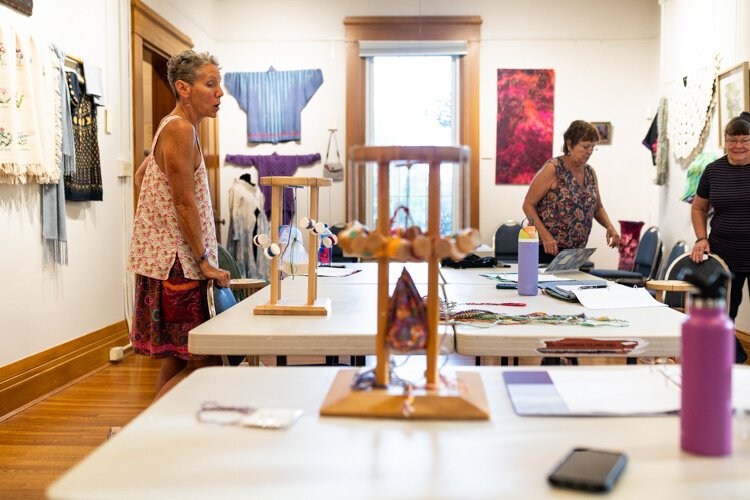 One of the workrooms where members may work together on projects in a shared space.A lot of the members of the Guild certainly love fibercrafts as a hobby, but there’s something deeper going on in their community.
One of the workrooms where members may work together on projects in a shared space.A lot of the members of the Guild certainly love fibercrafts as a hobby, but there’s something deeper going on in their community.
Medieval guilds were like the first workers’ unions, Ostaszewski explains. They existed to protect workers and to protect the integrity and the quality of the craft. While a formal guild system doesn’t really exist for traditional crafts anymore, communities like the Weavers Guild of Greater Cincinnati are aiming to preserve standards of excellence in the craft and provide opportunities for personal connection and development.
“We are here to support each other,” she explains.
“It’s like somehow getting to know yourself by connecting with others and helping support each other.”
As with many folk traditions, love for craft is often born from early exposure in the context of family or another close community, often passed down from a mother, grandmother, or other female family member.
There is one thing Maley, Ostaszewski, and Yates all have in common—their craft is a part of their heritage. And one of the things they love most about being a part of the Weavers Guild is its sense of community and the opportunity to continue to pass on the human heritage of weaving to others.
Enjoy this story? Sign up for free solutions-d reporting in your inbox each week.
